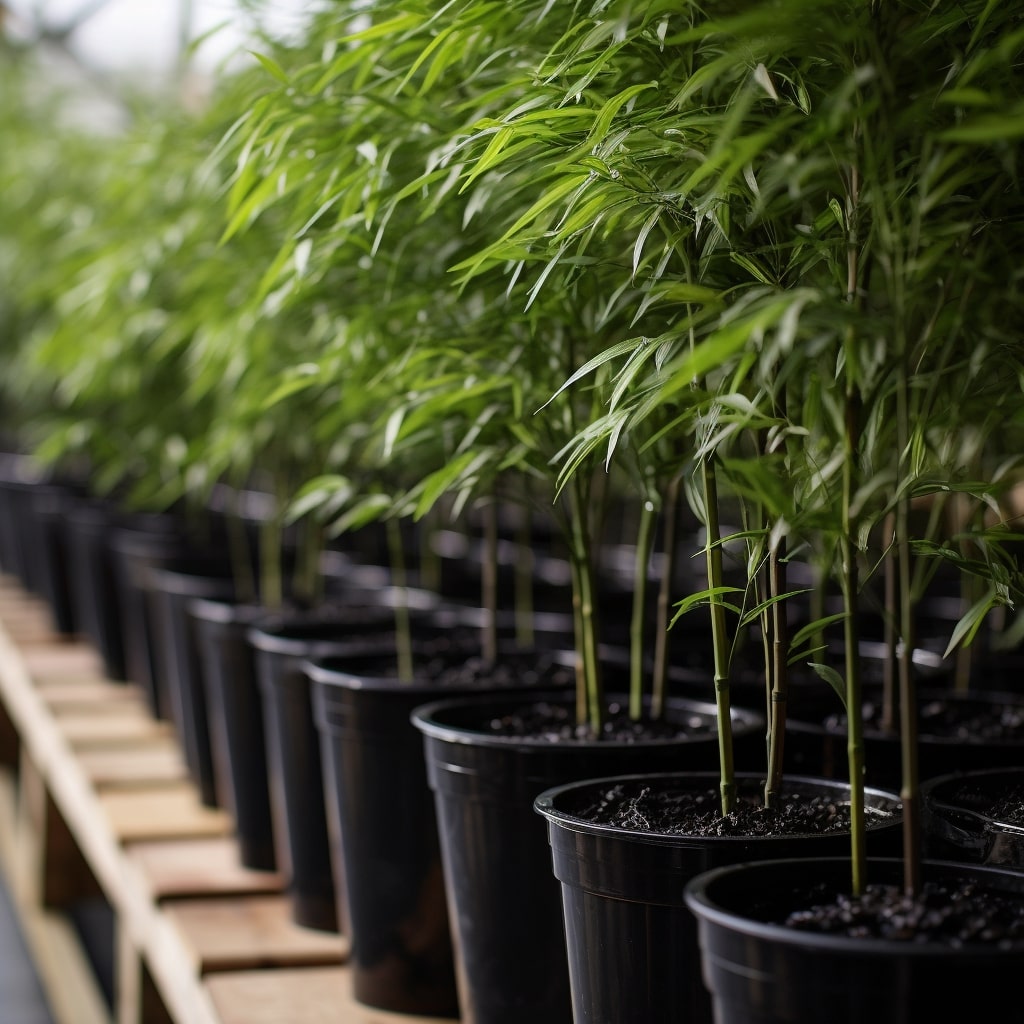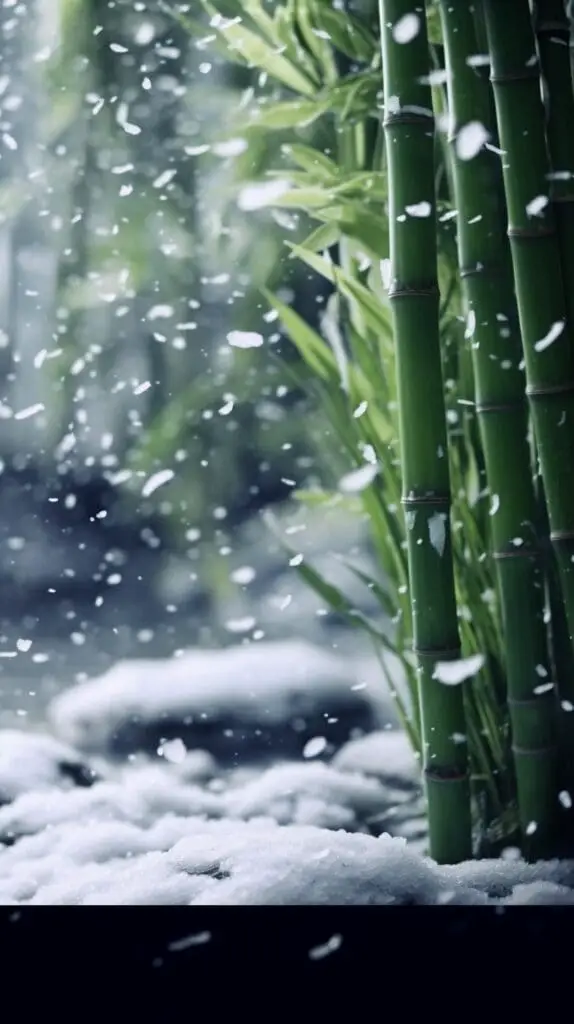Bamboo, known for its rapid growth and tall stalks with lush foliage, is not native to Idaho. However, with proper care and protection, certain cold-hardy bamboo species have the potential to thrive in the state.
Key Takeaways
- Bamboo does not grow natively in Idaho due to the harsh climate and soil conditions
- Certain cold-hardy bamboo species can potentially grow in Idaho with proper care and protection
- Tips for growing bamboo in Idaho include selecting cold-hardy species, choosing a sunny and well-draining location, regular watering, mulching, and protecting plants during winter
Suitable Bamboo Species
In considering the suitability of bamboo for growth in Idaho, it is important to explore the various cold-hardy species that have the ability to survive in this region’s challenging climate and soil conditions. Bamboo species selection is crucial in order to ensure successful cultivation.
While bamboo does not grow natively in Idaho due to its harsh climate and soil conditions, there are certain cold-hardy species that can withstand these challenges with proper care and protection. Please see further below for some species suggestions.
It is advisable to choose bamboo plants from local or northern nurseries as they are better adapted to the specific climate conditions of the area. By selecting appropriate species and following expert advice, it is possible to cultivate bamboo successfully in Idaho’s cold environment.
Planting Requirements
When considering planting requirements for bamboo in Idaho, it is essential to dig down to a depth of 3 feet for running bamboo and 16 to 20 inches for clumping bamboo, ensuring that the soil is broken up into small clumps no larger than golf balls. This promotes proper drainage and prevents waterlogged conditions that can be detrimental to bamboo growth.
Additionally, choosing the right location is crucial for successful bamboo planting. Select a sunny spot to provide optimal growing conditions.
As for watering, it is recommended to water newly planted bamboo 2 to 4 inches and keep the soil consistently moist but not drenched. Once established, monitor the top 1/4 inch of soil and water when it begins to dry out.
Protection from Winter
To ensure the survival and thriving growth of bamboo in Idaho’s harsh winters, proper protection measures must be implemented. Winter insulation is crucial to shield bamboo plants from freezing temperatures and frost damage.
One effective method is to cover the plants with burlap or frost blankets, creating a barrier against cold winds and retaining heat around the foliage. Additionally, planting bamboo near wind-blocking structures such as fences or buildings can provide natural wind protection.
Mulching around the base of the bamboo with a layer of organic material like straw or leaves helps insulate the roots and prevent frost penetration into the soil. It is important not to break off frozen snow and ice that may accumulate on the plants, as this can cause damage.
Grow Bamboo Plants in Containers
Container bamboo cultivation offers a practical solution for bamboo enthusiasts, allowing for easy mobility and protection during freezing temperatures. By planting bamboo in containers, growers have the flexibility to move their plants to a more sheltered location when winter arrives. This is especially beneficial in colder regions like Idaho, where harsh winter conditions can be detrimental to bamboo growth.

Additionally, container bamboo provides an opportunity to grow less cold-hardy species that you want to grow but would not otherwise survive the climate. Some popular container bamboo varieties include Fargesia nitida ‘Jiuzhaigou’, Phyllostachys aurea ‘Koi’, and Pleioblastus pumilus.
Care for container bamboo involves using well-draining soil, ensuring proper drainage holes in the containers, regular watering, and occasional fertilization.
Winter Leaf Shedding
Winter leaf shedding in bamboo plants is a natural response to cold temperatures and serves as a protective mechanism against excessive water loss and potential damage.
During the winter, bamboo plants go into a dormant phase, where they conserve energy and resources. As part of this process, the leaves of bamboo may turn yellow or brown and eventually fall off. This shedding of leaves helps to reduce water loss through transpiration, as the plant’s metabolism slows down during colder months.
It is important not to panic if you notice your bamboo plants losing their leaves in winter, as this is a normal occurrence. The underground parts of the bamboo plant are likely still alive and will regrow new leaves in the spring when temperatures rise again.
It is recommended to leave the fallen leaves around the base of the plant as mulch, providing additional protection for the roots during freezing temperatures.
Snow and Ice Management
Snow and ice management is an important aspect of caring for bamboo plants in cold climates. Proper maintenance during winter ensures the health and longevity of the plants.
One key practice is winter pruning, which involves removing any damaged or weak culms to promote new growth in spring. This helps maintain the overall shape and appearance of the bamboo stand.
Additionally, snow removal is crucial to prevent excessive weight from bending or breaking the bamboo stalks. It is recommended to gently shake off accumulated snow from the plant without forcefully breaking off frozen snow or ice, as this can cause damage. Leaving bamboo under heavy snow strain can lead to long-term harm.
Bamboo Varieties in Idaho
While bamboo is not native to Idaho, there are certain species that can thrive with proper care and protection. Due to the wide variance in climate across the state, it is important to select bamboo varieties that are suitable for your specific USDA hardiness zone. Most parts of Idaho fall within zones 4 to 6, but some areas can be as low as zone 2 or as high as zone 7.
Several bamboo species that are suited to USDA hardiness zones 4 to 6 include:
1. Phyllostachys aureosulcata (Yellow Groove Bamboo): This species is hardy down to USDA zone 4 and is known for its yellow culms with green stripes. It can reach heights of 30 to 40 feet.
2. Phyllostachys nigra (Black Bamboo): Black Bamboo is hardy down to USDA zone 5 and features black culms that turn a deep green with age. It can grow up to 30 feet tall.
3. Fargesia nitida (Blue Fountain Bamboo): This bamboo species is suited for USDA zone 5 and can tolerate some colder temperatures. It has attractive blue-green culms and reaches heights of 10 to 12 feet.
4. Phyllostachys bissetii (Bisset Bamboo): Bisset Bamboo is hardy down to USDA zone 5 and is known for its dense growth habit. It can reach heights of 20 to 30 feet.
5. Semiarundinaria fastuosa (Temple Bamboo): This bamboo species is suitable for USDA zones 5 to 6 and features thick culms with a unique blue-green color. It can grow up to 25 feet tall.
Remember that specific growing conditions, can affect the success of bamboo growth in these zones.
To ensure successful growth, it is recommended to purchase bamboo plants from local or northern nurseries that offer varieties adapted to your climate. These nurseries can provide expert advice on selecting appropriate species and offer guidance on planting techniques specific to Idaho’s soil conditions and weather patterns.
Planting and Watering Tips
When establishing a bamboo plantation in Idaho, it is vital to follow proper planting and watering techniques for optimal growth and health of the plants. Bamboo growth rate can vary depending on the species and growing conditions.
Before planting, it is important to prepare the soil by digging down 3 feet for running bamboo or 16 to 20 inches for clumping bamboo. Large clumps of soil should be broken up and smoothed with clumps no larger than golf balls. For running bamboo, a bamboo barrier extending 33 to 36 inches deep and 2 to 3 inches above the soil should be used to contain its spread. Clumping bamboo does not require a barrier.
When planting, lay the bamboo with the eyes of rhizomes facing up and backfill the hole. Mulching the area with straw, leaves, or organic mulch can help retain moisture in the soil.
Watering should be done when the top 1/4 inch of soil dries out and the bamboo has 4 to 5 segments on its culms.
Pruning techniques may vary depending on personal preferences and desired plant shape, but regular pruning can help maintain healthy growth and prevent overcrowding within the plantation.
Frequently Asked Questions
Q: Where can I find a nursery to buy bamboo in Idaho?
A: You can find a nursery called Horseshoe Nursery in Horseshoe Bend, Idaho.
Q: Can bamboo survive in Idaho winters?
A: Yes, bamboo can survive in Idaho winters. However, it is important to choose a hardy species and take measures to protect the bamboo from extreme cold.
Q: How can I protect my bamboo in winter?
A: To protect your bamboo in winter, you can apply a layer of mulch around the base of the plant to insulate the roots. It is also helpful to choose a species that is hardy and tolerant of cold temperatures.
Q: What is the USDA Plant Hardiness Zone for Idaho?
A: The USDA Plant Hardiness Zone for Idaho is generally Zone 5.
Q: How long does it take for bamboo to grow?
A: Bamboo can grow to its full height within 3 years if it is well cared for.
Q: Can bamboo withstand windy conditions?
A: Yes, bamboo is generally wind tolerant, but it is still important to protect it from strong winds by planting it in a sheltered location or providing some kind of windbreak.
Conclusion
It is possible to cultivate certain cold-hardy bamboo species in Idaho with proper care and protection.
By selecting suitable species, choosing a sunny and well-draining location, providing regular watering and mulching, and protecting plants during winter, individuals can successfully grow bamboo in Idaho.
Consulting local gardening experts or horticulturalists for advice on suitable species and cultivation techniques is recommended.

